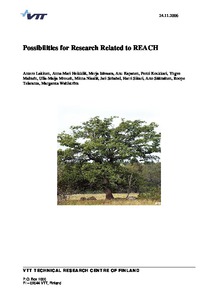Possibilities for research related to REACH
"REACH is a driving force for innovation. New business opportunities are currently being valuated all around Europe and companies providing REACH related services are developing innovative new concepts for future business. Some business, such as testing of chemicals, preparation of registration...
| Main Authors: | , , , , , , , , , , , , , |
|---|---|
| Institution: | ETUI-European Trade Union Institute |
| Format: | TEXT |
| Language: | English |
| Published: |
Espoo
2006
VTT |
| Subjects: | |
| Online Access: | https://www.labourline.org/KENTIKA-19188664124919068469-Possibilities-for-research-rel.htm |
| Summary: | "REACH is a driving force for innovation. New business opportunities are currently being valuated all around Europe and companies providing REACH related services are developing innovative new concepts for future business. Some business, such as testing of chemicals, preparation of registration dossiers and exposure scenarios, and development of REACH data systems, are already relatively well defined. Others, like development of in vitro or in silico alternative testing methods, or new products and processes, may need much more innovative research work before they can be commercialised. The purpose of this discussion paper is to highlight those possibilities for research that are related to REACH and, if successful, can eventually form a basis for future business activity. Nowadays, a wide variety of existing data needs to be collected and used for risk assessment. And REACH requires physicochemical, toxicological and ecotoxicological information of substances and their use for the estimation of risk. Many of the testing methods authorised by, for example, the OECD Test Guidelines, are scientifically valid and the results are accurate. But some physicochemical parameters, such as the noctanol/ water partition coefficients, may need further research due to the data deviations. There is an undisputable trend in the development of alternative methods for replacing several standard animal tests used for the measurement of toxicological endpoints, and the greatest expectations lie on the development of in vitro and in silico testing methods. Environmental hazard classification in REACH requires the assessment of aquatic toxicity, degradation and bioaccumulation of substances. In order to develop new innovative molecules and processes, industry may also need fast screening tests for chemicals. ... " |
|---|---|
| Physical Description: | 65 p. Digital |

